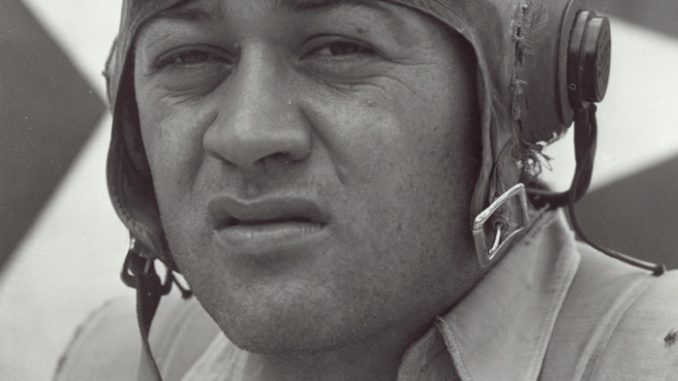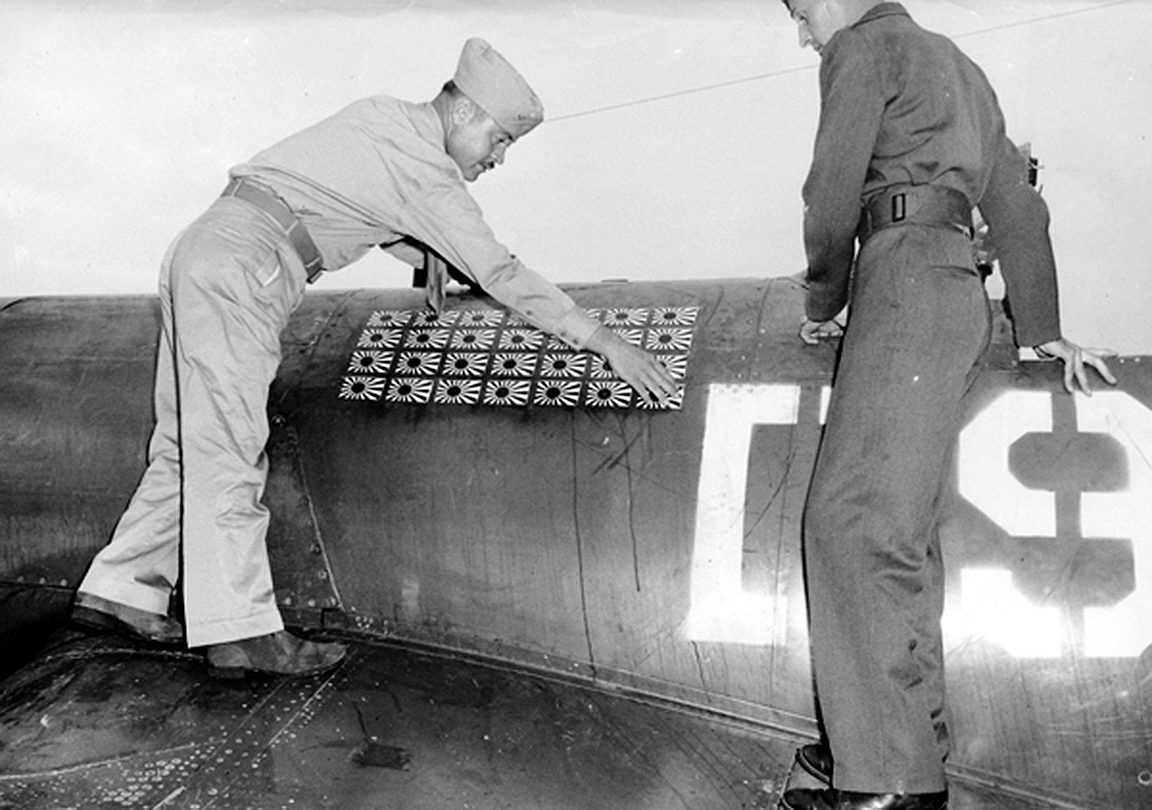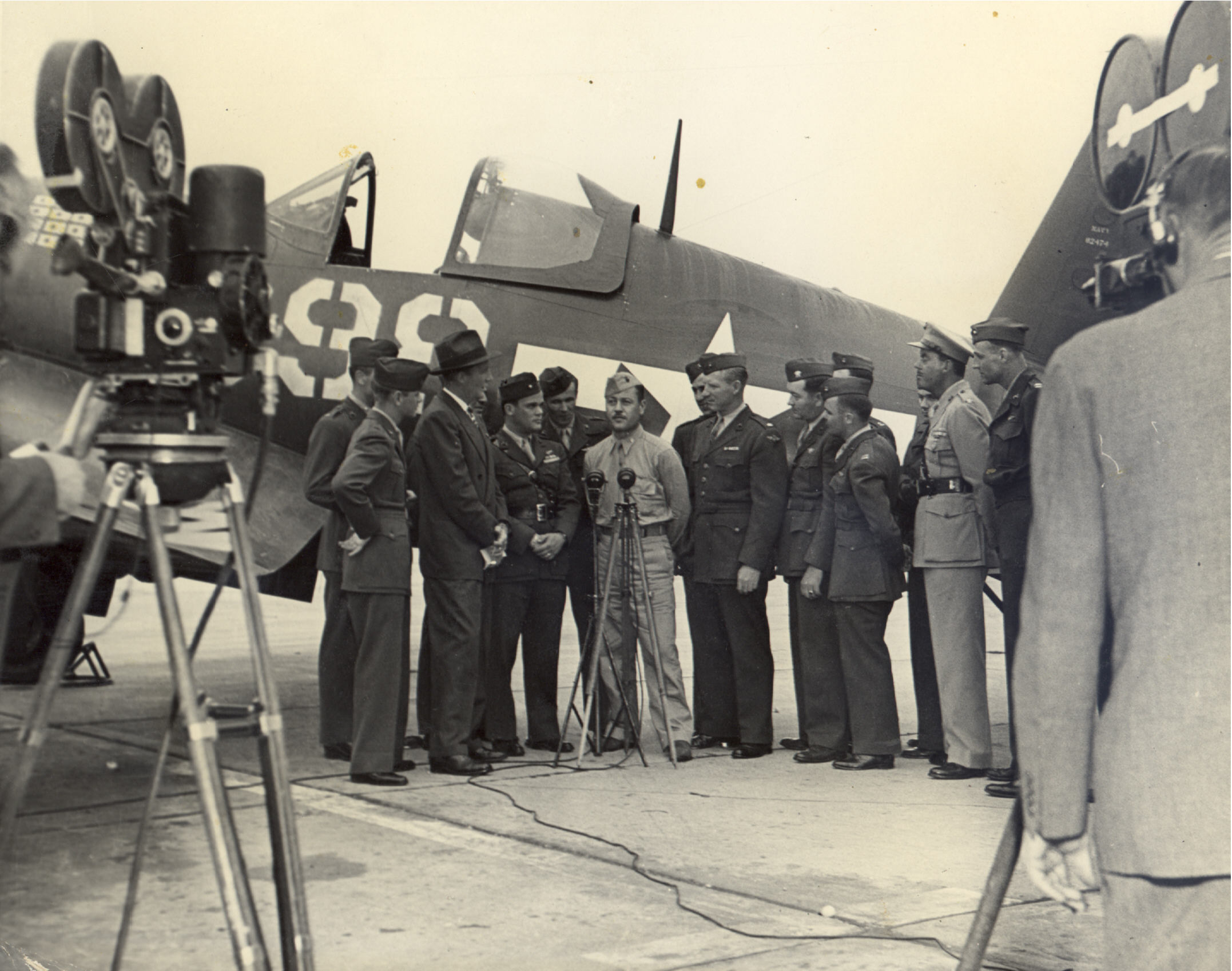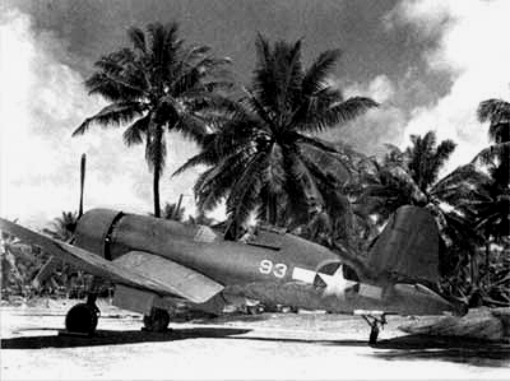
Gregory ‘Pappy’ Boyington, the legendary leader of VMF-214, Blacksheep Squadron, is one of those characters in military lore whose deeds and abilities have largely been swallowed up by the myth that has grown up around the man in the decades since WWII. It is very difficult to separate the man from the fiction, but what we can examine the contemporary documents from his time leading VMF-214 to get some sense of what he was as a leader and tactician, but without the confusion of later hyperbole. Newly minted WarbirdsNews contributor, Dr. John M. Curatola, former US Marine, and associate professor in the Department of History at the US Army Command and General Staff College in Fort Leavenworth, Kansas has taken a look through Boyington’s reports from his time at VMF-214, and written a fascinating appraisal of the man as commander and tactician. We hope you enjoy what he has to say in the following article.
Pappy’s Procedures
by John M. Caratola, PhD.
Of the many brave men who’ve participated in aerial combat, ‘Pappy’ Boyington stands out in the annals of aviation history. As the commander of VMF 214, flying F4U Corsairs in the south Pacific in late 1943, his combat skills have become the stuff of legend. However, like any legend there are kernels of truth wrapped around hyperbole. What most don’t realize is that while Pappy was indeed an unconventional Marine officer, he was an excellent tactician and practitioner of aerial combat. The image of him as a renegade, devil-may-care warrior belies his professionalism as an aviator and deliberate approach to the many nuances of aerial combat. In contrast to his popular persona as an undisciplined and unruly aviator, he recognized the importance of careful preflight planning, preparation, and attention to detail.
In a February 1944 report that specifically studied Boyington’s tactics, it is clear that he was not just a “seat-of-the-pants” aviator with a reckless, cavalier attitude. Quite the opposite is true as his preparation for combat and development of tactics, techniques, and procedures were deliberate, thoughtful, and well considered. Even before take-off Pappy conducted thorough briefings that addressed the nature of the mission in detail, its purpose, specific navigation and heading information, altitudes, alternate targets, leader/wingman responsibilities, rendezvous points, possible contingencies, and accurate weather information. He also understood the importance of exploiting the sun, weather, and terrain in the conduct of the mission and used it to his squadron’s advantage. Furthermore he required aircrew to conduct methodical preflight checks, especially of their Corsair’s oxygen systems. Interestingly, he was also concerned with the maintenance of the national insignia on the aircraft. In order to facilitate identification, he required that the stars and bars be freshly painted and maintained. Due to the nature of the environment in the combat zone, the national insignia would often fade because of exposure to the sun or from the abrasion from sand, dirt and coral dust prevalent at the airfields and the regular washing the maintenance teams had to do because of it.

Once airborne, Pappy was just as methodical. He emphasized that all pilots be vigilant and develop an individual scanning method of the surrounding airspace for any possible enemy attacks. Furthermore, crews were to develop the ability to quickly identify friend from foe. For the fighter pilot, speed is life, and it was key to the Corsair’s success in combat. Boyington made a point to maintain high speeds through danger areas at a rate that all aircraft in the formation could maintain. In the same vein, he usually sought to avoid a climb into the attack from a lower altitude. Instead he preferred to dive on the enemy from above using the power of the Corsair’s 2,000hp R-2800 engine and attack from the front or rear of a Japanese formation. Having an understanding of enemy aircraft engine horsepower limitations, he also knew that his foe could not catch the Americans in such a profile. Furthermore, his close appreciation for the F4U’s sturdy construction told him that, should the Japanese give chase, the Corsair’s self-sealing fuel tanks and armor plate minimized the aircraft’s rearward vulnerability to fire. Slashing attacks were the preferred method for the faster and more powerful Corsairs, while avoiding a close turning fight that usually played to a Japanese fighter’s advantage.

When attacking, the Corsair packed considerable firepower with its six .50 caliber machine guns. Through his own field testing and experience, Boyington determined the best mix of tracer, armor piercing, and incendiary rounds in the machine gun ammunition belts was not the standard even mix of 1 tracer, 1 armor piercing, and 1 incendiary for a 1-1-1 combination. His squadron went with the combination sequence of 2 incendiary, 1 armor piercing, 2 incendiary, and one tracer for a 2-1-2-1 belting combination. This mix of ammunition was more effective against the lightly-built and easily flammable Japanese fighters that also lacked the armor plate and self-sealing fuel tanks that American aircraft had.
Boyington also saw the need for proficiency training for his crews. Boring duties such as fighter patrols and task force top cover flights were considered opportunities to develop required combat skills. Pilots receiving these duties were to practice their formation flying for both section leads and their wingmen, with the crews switching positions periodically. Pappy also had them practice combat air maneuvers such as tight turns, violent rolling scissors, and section movements. Additionally, he wanted crews to develop their long range observation and scanning practices. As a result, mundane activities were turned into training opportunities to increase overall squadron proficiency and combat effectiveness.
In addition to air-to-air combat tactics, Boyington also developed methods for effective ground strafing maneuvers. Understanding the effectiveness of such attacks, he developed procedures that minimized aircraft vulnerability to ground fire, while maximizing damage to the enemy. He concluded that low-level runs should be made at high speed. While this minimized the number of rounds delivered and diminished observation during any given pass, it had the overriding benefit of reducing the enemy’s ability to target an individual aircraft during its attack run. Pappy also had pilots fly at a constant power setting, allowing them to focus more closely on the target, thus increasing accuracy and lessening the risk of overshooting a given target, which could easily happen with a quick throttle boost. Aircraft were to fly, not in column, but in a flat echelon to maximize damage on the ground. If the target was too small to attack in a flat echelon, the Corsairs were to attack from different angles as simultaneously as possible. Once the aircraft has completed the strafing run, egress from the target was to be low and fast with a watchful eye for rising water spouts resulting from enemy fire from the rear.

As well-documented, VMF 214 under Boyington was a marvel of combat efficiency. In a short span of about four months his “Blacksheep” squadron destroyed 94 enemy planes in aerial combat, claiming another 32 as “probables”, with 50 more counted as “damaged.” Not only did Pappy’s squadron claim victories over enemy aircraft, but they were also credited with destroying 20 enemy barges and 15 other vessels during strafing attacks along with many Japanese troop concentrations on various islands. Boyington is often represented as a misfit and undisciplined officer, but this persona belied his true professionalism, diligent study, and preparation for aerial combat. While Boyington may have been irreverent and struggled with inner demons in his personal life, he was a calculating, attentive, and conscientious aerial tactician once he made his way to flight line.
——————————————-
WarbirdsNews wishes to express its gratitude to Dr. John M. Curatola for this fascinating insight into the legendary Pappy Boyington. We look forwards to Curatola’s next article, which expect will cover the fascinating subject of aircraft nose art.


i WAS IN 214 IN 19550 Cherry Point NC
Unfortunately, pilots who were part of the Original Flying Tigers and the Crew Chiefs are not with us today so they cannot comment on this article. They did not think highly of Pappy. In their opinion he was a a heavy drinker who probably would have been court martialed if he had not gone missing……………
Peter;
I managed to meet a lot of guys under his command of VMF-214; they were INCREDIBLY loyal to him, and protective of his memory.. .alhough they were initially pretty irritated by his participation in the TV show “Baa Baa BlackSheep/”Black Seep Squadron”.
I once spoke to “Tex” Neal, one of the orig Tigers, not long before h-e died. .and he was one who rather despised Boyington. Tex had his OWN ego, though-hell, he was from Texas. .:)
When given a command, and given a chance to mature, people like him(Boyington) can rise to the occassion. I believe Jim Hill is the only surviving member of VMF-214.. in a nursing home. I first met him nearly 20 years ago.
I got to know Dick Rossi rather well; he was the “unoffical” historian of the the Tigers, and was Boyington’s cabin mate on the way over to China under the employ of “Camco”, a paper front-company. He still had fairly good memories of the man was later actually to be called “Gramps”.. . in VMF-214.
as was said in ” The Man who Shot Liberty Valance”……..”When Legend becomes Fact………Print the Legend..”
I listened to Pappy Boyington give a speech in 1975 in CA when I was based at Edwards AFB. His speech was good, but could have been better had he drank a little less. I also ran into his son occasionally when I was based at Randolph AFB Tx. Because his dad was was a MOH winner, Greg was an automatic selectee for the AF Academy.
Gregory Boyington is officially credited with 3 and a half Japanese airplanes shot down. Some records indicate it should have been 4 and a half. After the Flying Tigers were “fired,” he went home and joined the Marines and (officially) shot down 22 more Japanese airplanes, before being shot down himself and spending the rest of the war in a Japanese prison camp. To quote Daniel Ford’s book on the Flying Tigers: “They were there: Mercenaries, gamblers, innocents, black marketeers, romantics, war lovers – they were there when the British Empire was falling, and when America’s future seemed nearly as bleak.” I don’t think anyone can pick on Boyington for being a bad-ass. s/ Robert J. Huston, acquaintance of Robert T. Smith, Peter Wright, and Robert Prescott (Flying Tigers all.)
None of us is perfect, and Boyington’s history reveals that. However, I’m thankful he was on our side and did what he did.
One of our church deacons was a Marine in the Solomons. He knew Greg Boyington, said he was everything he was cracked up to be. He knew JFK also, said he was morr show than anything else
Without a doubt he was the consumate professional who excelled at his job.